The #WorldWineTravel group is kicking off 2021 by virtually exploring wine regions around the world, one country or region at a time. Our focus in 2021 will be Spain, and we start in Rioja, the country’s fine wine capital.
About Rioja
The storied history of the area known as La Rioja dates back 3,000 when the Phoenicians, who were the first wine traders, settled in the Iberian Peninsula. You know the Romans had to have a piece of the action. The Romans brought their wine savvy to the region, resulting in better viticulture, wine quality, and increase production.
During the Middle-Ages the Catholic Church got involved by the late 1200s, Rioja was selling wines abroad. By 1560 the first wine regulations were established in the region to ensure quality and protect the Rioja “brand”
“In the mid-19th century, a series of civil wars caused some Spaniards to flee the country. Two men from Rioja, Marqués de Riscal and Marqués de Murrieta, went to Bordeaux. While there, they learned a lot from local vigneron. The pair ultimately brought this knowledge back to Rioja, revolutionizing its wine industry in both quality and volume.
Fortuitously, this all happened just before phylloxera began to devastate important French winegrowing regions. The sudden uptick in demand to replace French wine, plus improved accessibility as train travel came to Rioja, positioned it perfectly for success. Some Frenchmen even emulated Riscal and Murrieta in reverse, setting up their own wineries in Rioja.
In 1925, Rioja became Spain’s first, legally recognized Denomination of Origin for wine. When new classifications were introduced in 1991, Rioja was immediately upgraded to DOCa (Denominacion de Origen Calificada) status.” (Source)
Climate and Geography
“Some sources identify Rioja as a Mediterranean climate zone. It is not. Neither is it a maritime climate, despite being much closer to the Atlantic than the Mediterranean. Instead, Rioja has a substantially continental climate. That’s because it is surrounded by mountains, which effectively block it from intense maritime influences.
Summers in Rioja are hot, sunny, and without much rain. That’s preceded by a chilly spring, which inhibits an early start to growing seasons. Fortunately, autumn is generally amenable to extended hang time for the grapes. Winters are cold and snow is common.
The Rioja DOCa has three sub-regions: Rioja Alavesa, Rioja Alta, and Rioja Oriental. The climate does vary between these zones. The first two are further north and absorb more Atlantic humidity than Rioja Oriental, which is to the southeast and drier, slightly influenced by the Mediterranean Sea” explains wine expert Fred Swan (source).
Grape Varieties
Tempranillo, which accounts for about 75% of planted grapes is the premonidant variety of Rioja. Other permitted red grape varieties include Garnacha Tinta (Grenache), Mazuelo (Carignane), and Graciano.
In recent years there has been an increase in white wine grape varieties plantings in Rioja (though it’s less than 10% of wines produced) Viura (Macabeo) is the main white wine grape of Rioja. However, there are nine permitted white varieties, the best known are Chardonnay, Garnacha Blanca, Sauvignon Blanc, and Verdejo.
The Rebranding of Rioja
In 2018, the Consejo Regulador DOCa Rioja launched the three-word Spanish strapline – Saber Quién Eres (meaning ‘knowing who you are’) for its rebranding campaign which featured a series of changes to the region’s quality tiers and regulations. The changes became effective January, 2019
Here’s a recap:
- The Viñedos Singulares (Single Vineyard) category was added permitting labeling of wines across quality tiers to be labeled as such.
- Vinos de Municipio and Vinos de Zona may be added to wine labels. The sub-regions Rioja Alta, Rioja Alavesa, and Rioja Oriental fall into the Vinos de Zona category. Vinos de Municipio are villages or municipalities (see infographic below right for these two).
- New ageing requirements were introduced which allow for greater flexibility for producers (see infographic below left)
- Single variety white are now permitted.
- Traditional method sparkling wines ( Espumosos de Calidad de Rioja are now permitted to be produced in Rioja.
2008 R. López de Heredia Rioja Blanco Reserva Viña Tondonia
My wife and I spent a little over three weeks in Spain in 2013. Major destinations included Barcelona, La Rioja, San Sebastián, Madrid, Seville and Granada.
During our time in Rioja we visited Haro, the mythical capital of the Rioja Alta region. We stayed at Los Augustinos Hotel (highly recommended). Haro is a bite-sized, very charming town that is home to five wineries which were established more than a century ago.
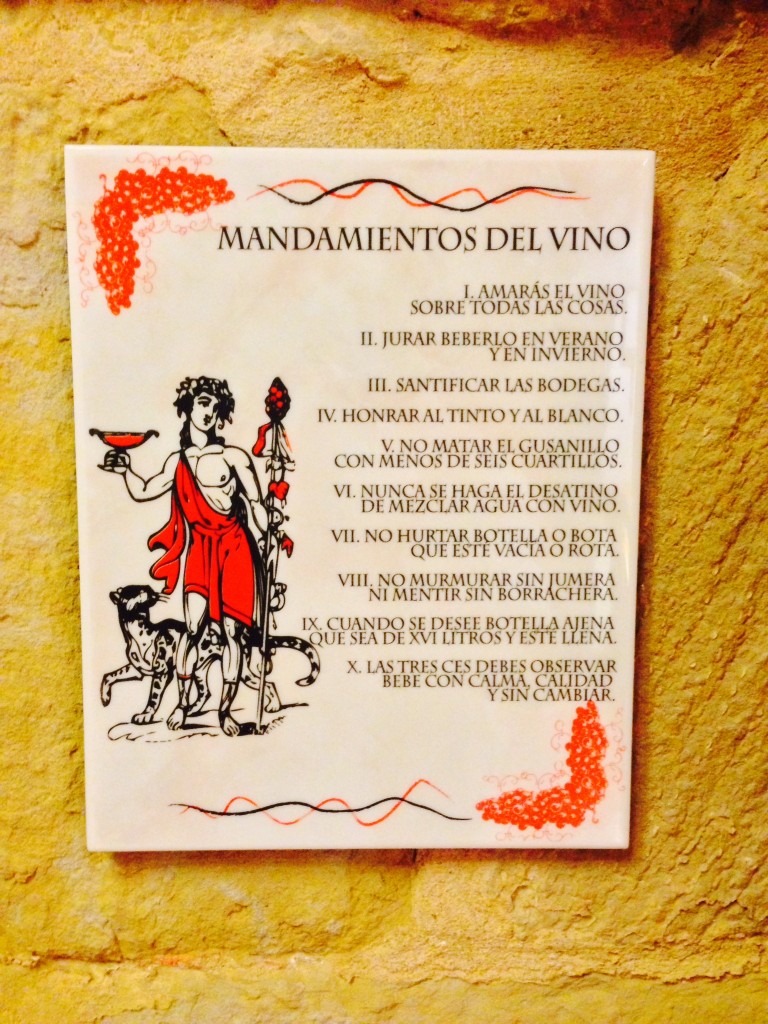
We only had time to visit one of those wineries. We chose Lopez de Heredia (“LdH”) because of its history, tradition and because they “elaborated” my favorite rosé of all time, the Rosado Gran Reserva Viña Tondonia (not necessarily in that order;-). I chose this wine because I realized I hadn’t had a Rioja Blanco since we returned from Spain (thereby making me a wine sinner since I broke Wine Commandment #4)
LdH was founded by Don Rafael López de Heredia Landeta in 1877. It is one of the oldest family owned wineries in La Rioja has a reputation for long aging of their wines, in the barrel and in the bottle. Here are “10 Things Every Wine Lover Should Know About López de Heredia“
“Perhaps no winery in the world guards its traditions as proudly and steadfastly as López de Heredia does, especially in a region like Rioja, which has been swept by profound changes in the last 25 years. And yet, as fusty and as backward-looking as López de Heredia may seem, it is paradoxically a winery in the vanguard, its viticulture and winemaking a shining, visionary example for young, forward-thinking producers all over the world.” -Eric Asimov, The New York Times
The source of grapes for this wine is Viña Tondonia, planted between 1913-14. It is one of the most spectacular in Haro, at over 100 ha. (with only 5-6 ha planted to Viura) situated in a shell like depression on the right bank of the river Ebro. The soil is alluvial clay with a high proportion of limestone, and it is widely regarded as one of Spain’s “Grand Cru” vineyards.
This wine was elaborated in the very traditional winemaking style, hand harvested and grape selection from old vines sourced from estate vineyards. It has spent 6 years in 225 ltr. American oak barrels, raked twice a year and fined with egg-whites, bottled unfiltered and followed by some ageing in bottle for a minimum of six months. Blend of 90% Viura/10% Malvasia.
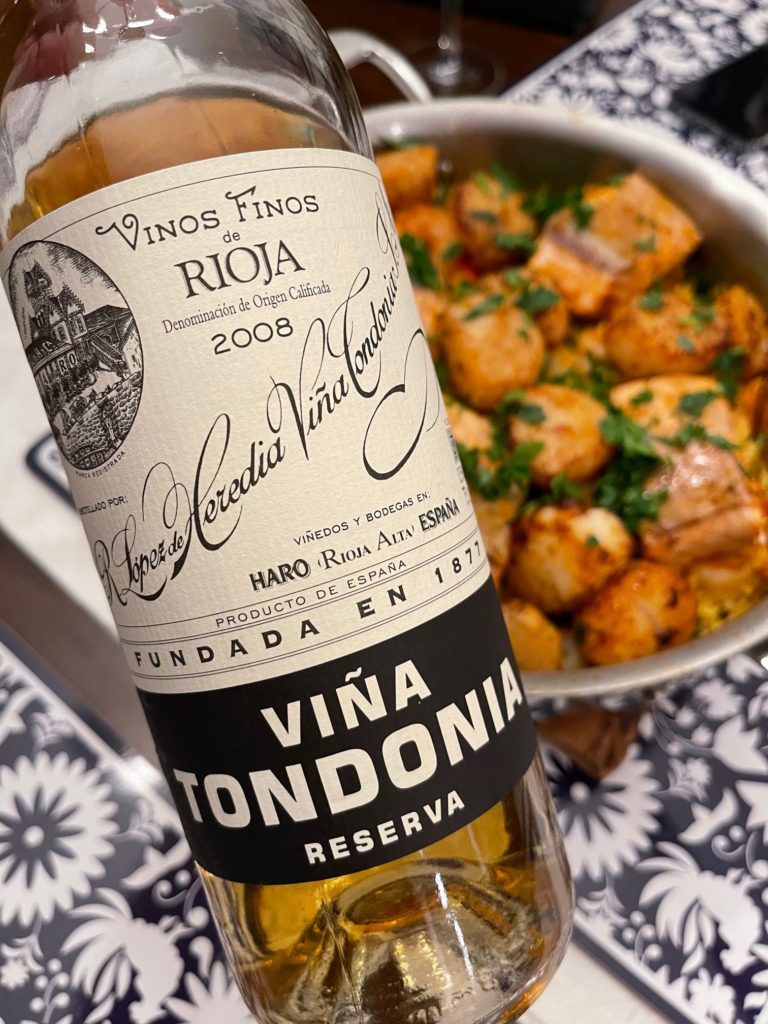
My tasting note follows:
Brilliant deep golden yellow color with inviting and complex aromas of lemon oil, white flowers, honeycomb, baked apricot, toasted almond and lanolin. On the palate it’s medium-full bodied with mouthwatering zesty acidity and a hint of tannins. What makes this wine remarkable for me is its texture. It show flavors largely mirror its aromas, but there’s also a very appealing saline minerality and just a hint of oxidation. Long finish. 12.5% abv| SRP – ~$48|92pts
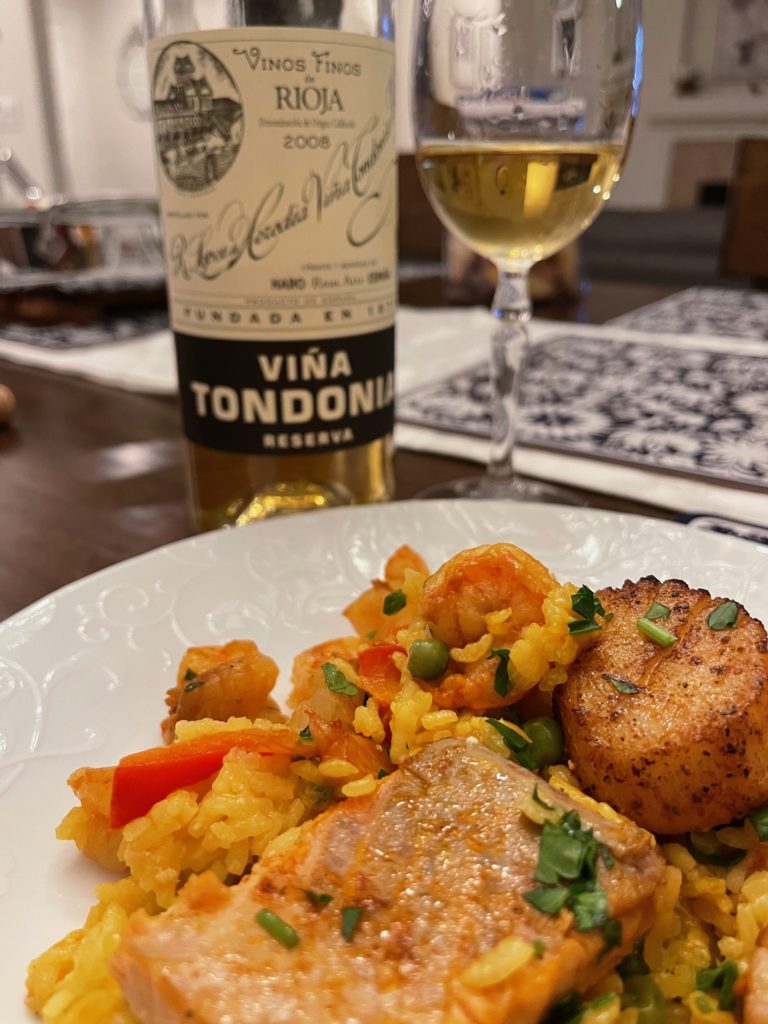
I wish I had more of this remarkable wine. It reminds me of how great Rioja Blanco can be!
I invite you to check out what our #WorldWineTravel team discovered during their virtual visit to Rioja:
- Andrea at The Quirky Cork shares “Marqués de Cáceres Crianza with Chorizo Sweet Potato Pockets“
- Wendy at A Day in the Life on the Farm shares “Mexican Ham Soup and a Spanish Rioja Wine“
- Camilla at Culinary Adventures with Camilla shares “Catalan Coques + La Rioja Alta Viña Arana Rioja Gran Reserva 2014“
- Steve at Children of the Grape shares “Tasting Rioja With Aging Eyes“
- Allison and Chris at Advinetures share “Rioja: The Confluence of Tradition & Modernity“
- Robin at Crushed Grape Chronicles shares “Viura – There is more to Rioja than Tempranillo“
- David at Cooking Chat shares “White Bean Stew with Sausage and a Rioja“
- Lynn at Savor the Harvest shares “Revisiting Rioja: Vinedos Singulares with Bodegas Ontañon”
- Nicole at Somms Table shares “One Day in Haro“
- Lauren at The Swirling Dervish shares “White Rioja: There’s a Style for Every Palate“
- Linda at My Full Wine Glass shares “Classic Rioja Alta to kick off virtual trip to Spain“
- Terri at Our Good Life shares “Our First Rioja with Assorted Easy Tapas“
- Marcia at Joy of Wine shares “White Rioja: Taste and See What You’re Missing”
- Susannah at Avvinare shares “Exploring Legendary Winery Marqués de Riscal”
- Gwendolyn at Wine Predator shares “Regional Rioja: Tempranillo, Viura, Rosado paired with hearty soup, salad, lamb, patatas bravas”
- Martin at Enofylz shares “Reconsidering Rioja Blanco with the 2008 R. López de Heredia Rioja Blanco Reserva Viña Tondonia“
- Jeff at Food Wine Click! shares “Rioja Oriental – A Cinderella Story“
Follow me on Twitter, Facebook, Instagram, Vivino and for all things wine. As a wino with latent foodie tendencies, you’ll also find plenty of food and wine pairings, and wine related travel stuff! Become a fan and join ENOFYLZ Wine Blog on Facebook. Cheers!
Copyright Notice: This entire site is Copyrighted 2010-2021. All Rights Reserved. No unauthorized copying of any section of this site is permitted. If you wish to use any part of this site, contact me. For information on Copyright Law, see the official U.S. Copyright Office home page.
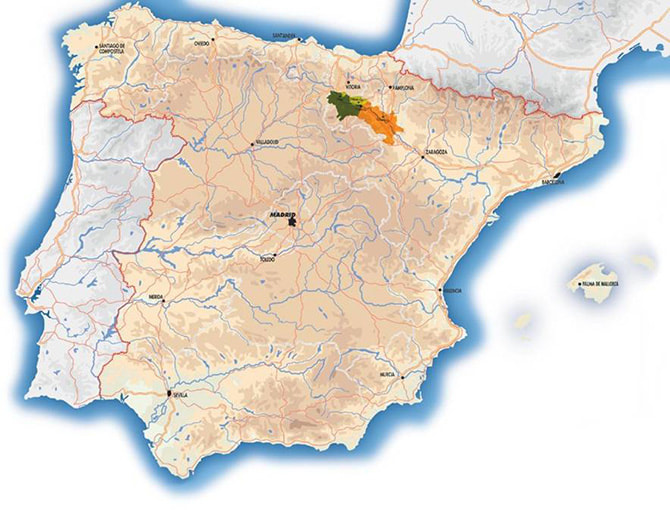

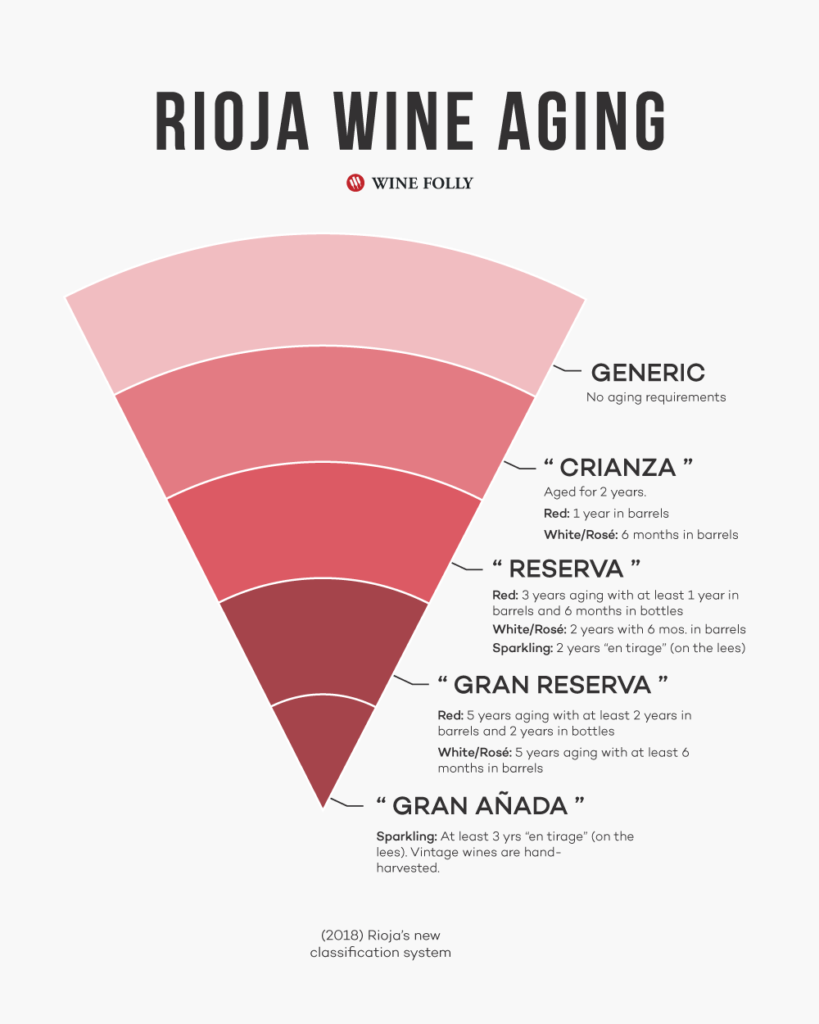
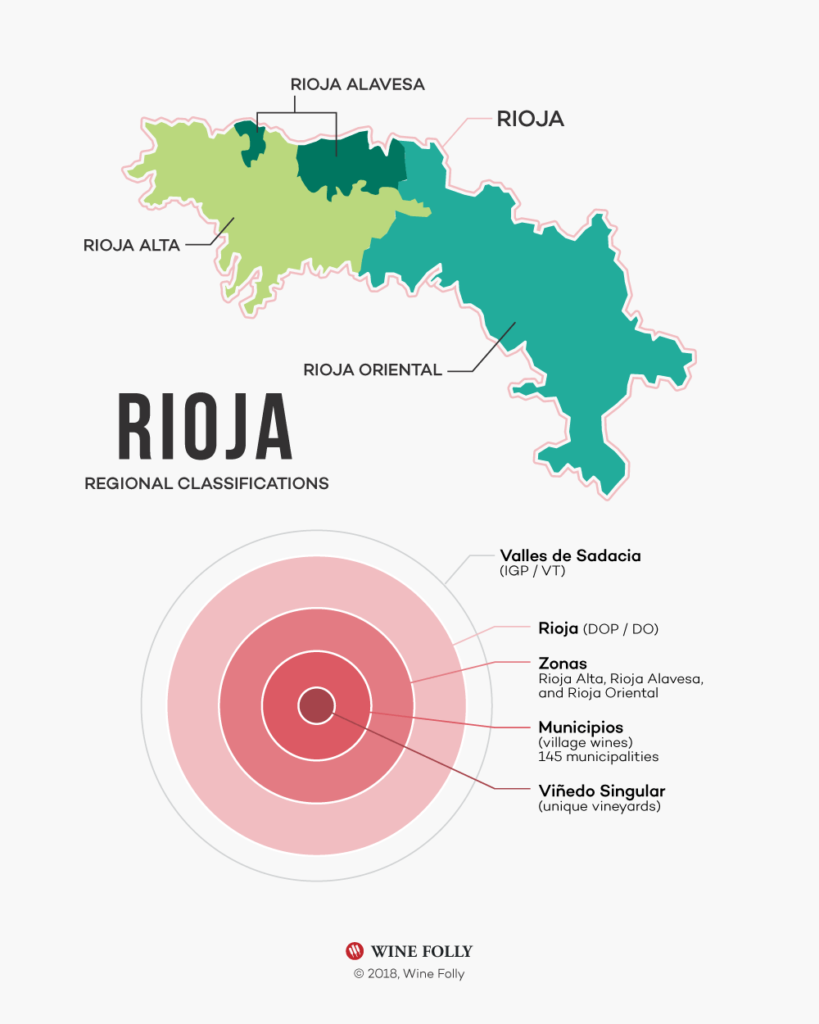
This wine does sound wonderful and your trip sounds amazing…..and, of course, the Romans had to get in on the action LOL>
Thanks Wendy! It was a great trip! Have you been?
What a joyful post! I am so envious of your visit to Rioja.
I don’t have a ton of experience with Viura and I was surprised that I got lanoline notes. I associate those notes with Semillon. As I notice you mentioned this also, is it typical on Viura, or perhaps just aged Viura?
You’re right about the lanolin…I don’t pick it up often in white wines. I do believe that extended aging gives this wine the lanolin character. Cheers!
When I saw your Insta post I couldn’t remember if you’d been. This is an absolute favourite in our house and the visit to the winery brings back such incredible memories every time we open a bottle!
I recall when we visited being so surprised to see the contemporary tasting area, but it didn’t take long to see the history of LdH. Fabulous bodega. Did you visit otherst that you would recommend?
Agreed…the contrast between the tasting room and those dungy tunnels was incredible! We also visited Roda, Muga, Remirez de Ganuza, & Remelluri…ALL of which we would recommend!
Reading this I am still so sad that we are locked down and can’t travel. For good reason, but I feel like we are missing so many adventures. I think I will definitely be visiting our friends from Spain as soon as I can. Can’t wait to track down this wine and try it for myself.
In many ways it’s hard to believe we’re still locked down almost a years later. And the vaccine roll out hasn’t gone well. We have flight booked for Portugal and Spain in October. When we booked it in later November, we felt good about it, but the doubt is growing every day!
I hope you can find a White Rioja…particularly one with a some age that has raised in oak. And I need to to the more “modern” style raised in stainless steel!
I love that this iconic winery is getting so much love! The whites are in short supply here, so although I have a bottle, they are not readily available. In order for our store to get a 6 pack of white, we have to buy 24 bottles of the Tondonia red! If one were to buy a bottle of Tondonia white at the store, it would cost $90/bottle CAD!
Wow…$90 CAD. That’s outrageous! If have found the LdH Blancos to be a challenge to find here in CA as well. I purchased my bottle in Nevada!
Love all this history, Martin! I had the sense there was a long tradition in Rioja but knew little of the detail.
How could you not visit this iconic producer when in Haro, right?!? When we first visited they hadn’t yet finished their modern tasting room. Second time what a contrast to see it. The lemon oil and lanolin stood out for me tasting this, what I consider brilliant, wine. Not a style for everyone but since I like things a bit off center, I’d take a case. How about you?
I share the Rioja Blanco love! This was my first time really delving into the style, and I learned so much. On my next trip to Spain (whenever that is), I’ll be stopping in Rioja for some more “research.”
How funny! It turns out we were both there in 2013. And I agree, these are such special wines and show such complexity and layers of flavor.
This topic certainly was a Rioja Blanco love fest! Your post has me craving this wine – and the paella to go with it.
I really like pinot noir if it goes with the lamb. What other types are suitable for this dish? European versions?
Pinot and lamb can be a very good combination. In terms of Seafood Paella, I’m also partial to enjoying it with Rosé (one from Spain would be a good match but Italian and French could work too) I’d also consider Italian white wines (Lugana, and Verdicchio are top of mind).
This is probably my favourite Rioja of all, including the reds!
I’d forgotten how good a Rioja Blanco can be. This was a fantastic wine Frank, and I can see why it’s your favorite Rioja!